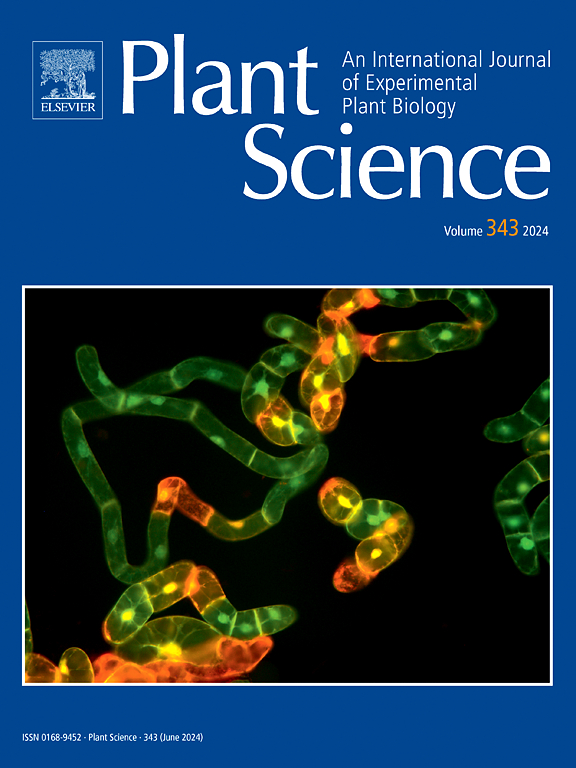Functional analysis of (E)-β-farnesene synthases involved in accumulation of (E)-β-farnesene in German chamomile (Matricaria chamomilla L.)
IF 4.2
2区 生物学
Q2 BIOCHEMISTRY & MOLECULAR BIOLOGY
引用次数: 0
Abstract
German chamomile (Matricaria chamomilla L.) is a traditional medicinal aromatic plant, and the sesquiterpenoids in its flowers have important medicinal value. The (E)-β-farnesene (EβF) is one of the active sesquiterpenoid components and is also a major component of aphid alarm pheromones. In this study, two EβF synthase (βFS) genes (McβFS1 and McβFS2), were cloned from German chamomile. Subcellular localization analysis showed that both McβFS1 and McβFS2 were localized in the cytoplasm and nucleus. Tissue-specific expression analysis revealed that McβFS1 and McβFS2 were expressed in all flower stages, with the highest levels observed during the tubular flower extension stage. Prokaryotic expression and enzyme activity results showed that McβFS1 and McβFS2 possess catalytic activity. Overexpression of McβFS1 and McβFS2 in the hairy roots of German chamomile led to the accumulation of EβF, demonstrating enzyme activity in vivo. The promoters of McβFS1 and McβFS2 were cloned and analyzed. After treating German chamomile with methyl jasmonate (MeJA) and methyl salicylate (MeSA), the transcription levels of McβFS1 and McβFS2 were found to be regulated by both hormones. In addition, feeding experiments showed that aphid infestation upregulated the expression levels of McβFS1 and McβFS2. Our study provides valuable insights into the biosynthesis of EβF, laying a foundation for further research into its metabolic pathways.
参与德国洋甘菊(Matricaria chamomilla L.)中(E)-β-法呢烯积累的(E)-β-法呢烯合成酶的功能分析。
德国洋甘菊(Matricaria chamomilla L.)是一种传统的药用芳香植物,其花朵中的倍半萜类化合物具有重要的药用价值。(E)-β-法尼烯(EβF)是其活性倍半萜成分之一,也是蚜虫报警信息素的主要成分。本研究从德国洋甘菊中克隆了两个 EβF 合成酶(βFS)基因(McβFS1 和 McβFS2)。亚细胞定位分析表明,McβFS1 和 McβFS2 均定位在细胞质和细胞核中。组织特异性表达分析表明,McβFS1和McβFS2在所有花期都有表达,其中管状花伸展期的表达量最高。原核表达和酶活性结果表明,McβFS1 和 McβFS2 具有催化活性。在德国甘菊毛根中过表达 McβFS1 和 McβFS2 会导致 EβF 的积累,这证明了酶在体内的活性。克隆并分析了 McβFS1 和 McβFS2 的启动子。用茉莉酸甲酯(MeJA)和水杨酸甲酯(MeSA)处理德国甘菊后,发现McβFS1和McβFS2的转录水平受这两种激素的调控。此外,喂食实验表明,蚜虫侵染会上调McβFS1和McβFS2的表达水平。我们的研究为 EβF 的生物合成提供了有价值的见解,为进一步研究其代谢途径奠定了基础。
本文章由计算机程序翻译,如有差异,请以英文原文为准。
求助全文
约1分钟内获得全文
求助全文
来源期刊

Plant Science
生物-生化与分子生物学
CiteScore
9.10
自引率
1.90%
发文量
322
审稿时长
33 days
期刊介绍:
Plant Science will publish in the minimum of time, research manuscripts as well as commissioned reviews and commentaries recommended by its referees in all areas of experimental plant biology with emphasis in the broad areas of genomics, proteomics, biochemistry (including enzymology), physiology, cell biology, development, genetics, functional plant breeding, systems biology and the interaction of plants with the environment.
Manuscripts for full consideration should be written concisely and essentially as a final report. The main criterion for publication is that the manuscript must contain original and significant insights that lead to a better understanding of fundamental plant biology. Papers centering on plant cell culture should be of interest to a wide audience and methods employed result in a substantial improvement over existing established techniques and approaches. Methods papers are welcome only when the technique(s) described is novel or provides a major advancement of established protocols.
 求助内容:
求助内容: 应助结果提醒方式:
应助结果提醒方式:


